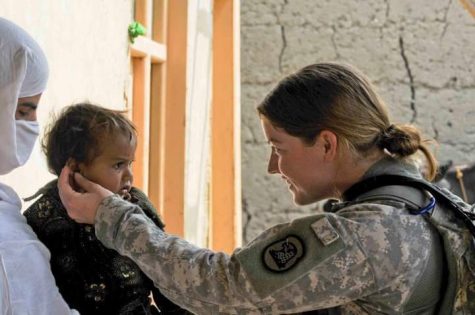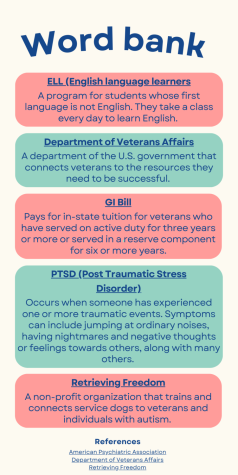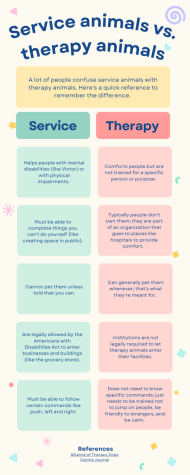From service to service dog
Everyone knows the teacher with the service dog, but not many know how Victor and Jessica St. John crossed paths.
Most people only see her as the woman with the service dog, but there is more to English Language Learners (ELL) teacher Jessica St. John then meets the eye. She didn’t like high school when she was a teenager, but she has a unique story that led her back to school.
Teaching and service
After St. John graduated from high school, she enlisted in the Army National Guard and served for eight years. While on a deployment in Afghanistan she discovered the importance of teaching. St. John constantly interacted with Afghans during deployment and realized that having an education should not be taken for granted.

“I realized how the lack of education and the way they [government of Afghanistan] were withholding it from people really led to them being ignorant and not being able to stand up for themselves,” she said.
She wanted to teach Afghans English but was frustrated that she didn’t know how.
“I had no idea what I was doing, it was awful,” she said. “They wanted to learn and I wanted to help them, and I was like, ‘Well, this should be easy. I know English.’”
But it wasn’t easy.
This frustration led her to pursue teaching, even though she wasn’t entirely convinced wokring in education was her place. After taking a few classes at a community college, her friend encouraged her to continue school.
She ended up going to the University of Northern Iowa and getting her schooling paid for by the GI Bill. She bounced around Iowa but finally settled at West because of its resources for students.

“I felt like I was more of a social worker because I was always trying to help them with basic needs,” she said. “I’ve just now gotten to where I can actually teach.”
While she found high school boring, St. John uses this negative experience to make it the opposite situation for kids in her class. She also feels this experience helps her connect with kids who also don’t like school.
“I also realized I don’t have to make my class boring,” she said. “I can connect well with kids that don’t like school.”
The best part of St. John’s job is that she sees students improve quickly, which doesn’t happen as much in different classes.
“You get to watch people change and grow really fast,” she said. “You get to see their progression faster than you would [in a different class].”
Service and Victor
After her service, St. John began having symptoms of Post Traumatic Stress Disorder (PTSD). PTSD is when someone has experienced or witnessed a traumatic event and has “intense, disturbing thoughts and feelings” about the event according to the American Psychiatric Association. These symptoms may include strong reactions to everyday noises, flashbacks, and many others. This is especially common in combat veterans like St. John.
She went to the Department of Veterans Affairs and they prescribed pills. However, she didn’t want to go on pills because of the high addiction rates to them, so she got a second opinion. They prescribed a service dog, but she wasn’t ready to get a dog just yet.
St. John was initially resistant to the idea of getting help because of the way she was trained in the military.
“It’s the Army person in me that’s like, ‘Oh, I don’t need kid gloves,’” she said.
St. John volunteered with Retrieving Freedom, a non-profit organization that trains and connects service dogs with veterans and other people with health conditions. At first, she helped train them, but after a suggestion by a therapist, she decided to get her dog, Victor.
“I really needed someone just to push me [to get a dog],” St. John said.
Victor helps her mitigate PTSD symptoms. He has four commands: left, right, lights and push. When St. John is in a crowded space, she can say “Victor left,” and he will move to her left. The crowd will part for the dog without her having to be impolite.
“I chose him as a form of medicine,” she said.

Victor can also turn on and off the lights using his nose to push the buttons for the lights. St. John doesn’t use this command as much because it’s unnecessary for her.
The last one, push, is intended for service dogs with their owner in a wheelchair, so buttons can be pressed. Of course, St. John doesn’t use this because she’s not in a wheelchair but because Retrieving Freedom didn’t know who Victor would be helping, he learned general commands.
Just having Victor there as comfort helps St. John too.
“[Victor] just being with me is the biggest [help],” she said.
Not only does he help her, but he also helps students in the classroom. If a student is having a bad day they can go over to Victor for a little comfort.
“There’s a huge difference between when he’s here and he’s not here,” she said.
Many ELL students come from places where dogs are undomesticated. Being around Victor also helps them become familiar with dogs. Audrey Bailey, a fellow ELL teacher at West notices the difference in student behavior too.
“[The students] finally being comfortable with him in the room is pretty amazing,” Bailey said.
While she didn’t expect to find herself back in the halls of high school, St. John has found purpose as an ELL teacher here at West.
You can follow Victor on Instagram @victor_theserviceboy.
Your donation will support the student journalists of West High School. Your contribution will allow us to purchase Scholarship Yearbooks, newsroom equipment and cover our annual website hosting costs.

(she/her) Yaya is a senior and this is her second year on staff. She is the sports editor and enjoys running cross country and track, making bracelets...


